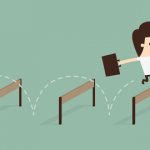Even though the internet tends to be perceived as a fierce competitor (crushed prices, broader offer, etc.) by brick-and-mortar shops, today’s shopping behaviours are multichannel: consumers easily switch from digital to physical. Distribution channels are not competiting with each other, nor are they depending on each other, instead they are interdependent of another!
Consumers created a hybrid or “phygital” (contraction of phy-sical and di-gital) shopping path for themselves. 91% of in-shop purchases are preceded by information research on the internet*: that’s the “ROPO” concept aka “Research Online, Purchase Offline.”
By collecting all kinds of information on prices, promotions, specifications, user feedback, availability, points of sale nearby, etc., the internet has become the place where consumers want to make sure they make the right choice, whereas physical shops are the place they actually buy from.
By combining the digital & physical distribution channels, customers created a hybrid “phygital” shopping path. The web-to-store principle matches this new purchasing behaviour and fullfills some consumer expectations that would not have been fullfilled (or even adressed) when considering each channel separately:
- Availability check. Time is precious and people don’t want to waste it wandering through a store to eventually realize the desired product is not available or out-of-stock. Customers want to make sure beforehand that the exact product they are looking for (in the desired color, size, dimension, etc.) is available in a specific store before having to actually go to that store in question.
- Experience: Customers want to actually see, touch, feel (or eventually smell) the product and make sure it corresponds to what they expected of it after having spoted it online. Detailed, up-to-date, and consistent product information featuring high quality media (pictures, videos, etc.) on the E-commerce platform are the first drivers of shopping motivations and the first level of product experience that is to be continued in-store to confirm the purchase intention or not.
- Advice: Shoppers want to be advised by a Sales person in store about a product they targeted online. They seek the guidance of experts.
- Emergency shopping: People collect the product they bought online in the store. That’s the “Click & Collect” or “Click & Pick Up” service, offered by more and more online merchants. Shoppers who choose this option do it because they need to collect the product asap. Maybe it’s the delivery time that is too long, the delivering hours that are not convenient, maybe they can’t or don’t want to go to the post office to pick up / return the parcel (hello reduced opening hours).
The web-to-store brings up great opportunities for retailers to increase their purchase rates as well as their average purchase value: it’s a way to bring customers to their store!
When a customer arrives at a point of sale (PoS), it’s not only time to collect what he or she bought online, it’s mostly time for the Sales person to share his or her expertise and advise the customer to stimulate additional purchases, e.g. by:
- Cross-selling, which is about selling a product that is complementary to the product that was initally purchased. It can enable its immediate usage (i.e. matches for candle, paper for printer), improve its usage (i.e. strap for guitar), or anticipate future needs (i.e. warantee extension.)
- Upselling, which is about selling a superior product to the one initially identified. Since this refers to an upgrade, all products can be taken into account: from a pair of shoes, a smartphone or a luxury car. This selling practice is only applicable when the sale is actually finalized in the brick & mortar shop, i.e. in the case of an appointment or e-booking.
In addition to these higher revenue opportunities, the web-to-store creates a new relationship between the customer and the brand. The customer is retained by the doubling of the brand’s touch points within one single shopping path: the brand website and the physical shop.
Stay tuned, we’ll later discuss the best web-to-store strategies for your e-commerce website including Click & Collect, e-booking, and many more!
Interested in knowing more about one of our customers that adapted to changing shopping behaviors, download our EBook:


